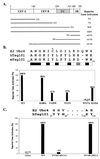Tsg101, a homologue of ubiquitin-conjugating (E2) enzymes, binds the L domain in HIV type 1 Pr55(Gag)
- PMID: 11427703
- PMCID: PMC35409
- DOI: 10.1073/pnas.131059198
Tsg101, a homologue of ubiquitin-conjugating (E2) enzymes, binds the L domain in HIV type 1 Pr55(Gag)
Abstract
Ubiquitination appears to be involved in virus particle release from infected cells. Free ubiquitin (Ub), as well as Ub covalently bound to a small fraction of p6 Gag, is detected in mature HIV particles. Here we report that the p6 region in the Pr55(Gag) structural precursor polyprotein binds to Tsg101, a putative Ub regulator that is involved in trafficking of plasma membrane-associated proteins. Tsg101 was found to interact with Gag in (i) a yeast two-hybrid assay, (ii) in vitro coimmunoprecipitation by using purified Pr55(Gag) and rabbit reticulocyte lysate-synthesized Tsg101, and (iii) in vivo in the cytoplasm of COS cells transfected with gag. The PTAPP motif [or late (L) domain] within p6, which is required for release of mature virus from the plasma membrane, was the determinant for binding Pr55(Gag). The N-terminal region in Tsg101, which is homologous to the Ubc4 class of Ub-conjugating (E2) enzymes, was the determinant of interaction with p6. Mutation of Tyr-110 in Tsg101, present in place of the active-site Cys that binds Ub in E2 enzymes, and other residues unique to Tsg101, impaired p6 interaction, indicating that features that distinguish Tsg101 from active E2 enzymes were important for binding the viral protein. The results link L-domain function in HIV to the Ub machinery and a specific component of the cellular trafficking apparatus.
Figures




References
-
- Swanstrom R, Wills J W. In: Retroviruses. Coffin J M, Hughes S H, Varmus H E, editors. Plainview, NY: Cold Spring Harbor Lab. Press; 1997. pp. 263–334.
-
- Arthur L O, Bess J W, Jr, Sowder R C I, Benveniste R E, Mann D L, Chermann J-C, Henderson L E. Science. 1992;258:1935–1938. - PubMed
-
- Luban J, Bossolt K L, Franke E K, Kalpana G V, Goff S P. Cell. 1993;73:1067–1078. - PubMed
Publication types
MeSH terms
Substances
Grants and funding
LinkOut - more resources
Full Text Sources
Other Literature Sources
Molecular Biology Databases
Research Materials

